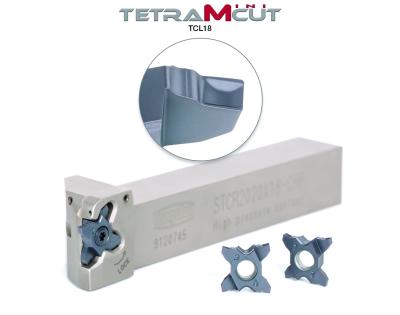
Tungaloy has expanded its TetraMini-Cut, a 4-edged grooving insert line to include TCL18 inserts in 1.75 mm and 2.5 mm thicknesses.
TetraMini-Cut features a small grooving insert with four economical cutting edges. Its innovative insert clamping design ensures secure insert retention and high repeatability, promising machining accuracy and tool life predictability.
TCL18 is designed to ensure light cutting action as well as good chip control when fed at low feed rates.
This expansion includes two new TCL18 inserts with 1.75 mm and 2.5 mm thicknesses, expanding the existing line of 1.5 mm, 2.0 mm, and 3.0 mm inserts. The inserts are available in grade AH7025, a nano-multilayer PVD coating with high-aluminum content that provides hardness and adhesion to the grade for better process security during grooving operations. Along with TCS18, TCG18, and TCP18 style inserts, the new TCL18 inserts provide an ideal solution for a vast array of grooving applications for general to miniature parts machining.
At a Glance
- TCL18 ensures consistent chip formation at low feed rates
- Available in AH7025
- Suitable for various materials including alloy steel, stainless steel, and heat-resistant superalloys
Contact Details
Related Glossary Terms
- feed
feed
Rate of change of position of the tool as a whole, relative to the workpiece while cutting.
- grooving
grooving
Machining grooves and shallow channels. Example: grooving ball-bearing raceways. Typically performed by tools that are capable of light cuts at high feed rates. Imparts high-quality finish.
- hardness
hardness
Hardness is a measure of the resistance of a material to surface indentation or abrasion. There is no absolute scale for hardness. In order to express hardness quantitatively, each type of test has its own scale, which defines hardness. Indentation hardness obtained through static methods is measured by Brinell, Rockwell, Vickers and Knoop tests. Hardness without indentation is measured by a dynamic method, known as the Scleroscope test.
- physical vapor deposition ( PVD)
physical vapor deposition ( PVD)
Tool-coating process performed at low temperature (500° C), compared to chemical vapor deposition (1,000° C). Employs electric field to generate necessary heat for depositing coating on a tool’s surface. See CVD, chemical vapor deposition.
- superalloys
superalloys
Tough, difficult-to-machine alloys; includes Hastelloy, Inconel and Monel. Many are nickel-base metals.

